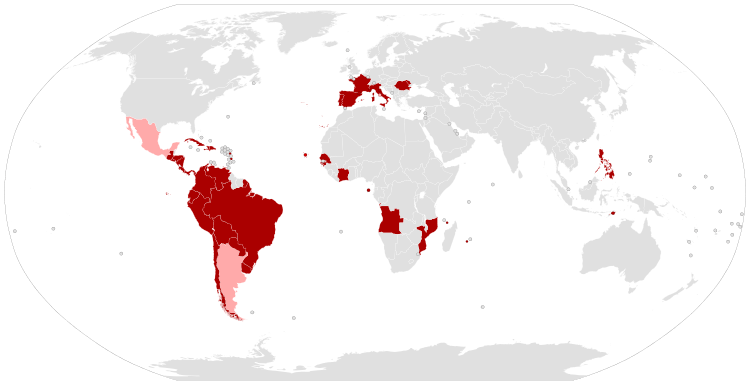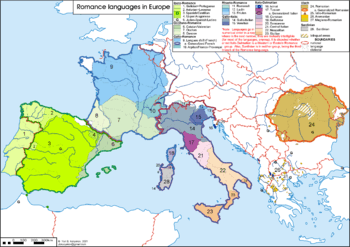Latin peoples
| Part of a series on |
| Indo-European topics |
|---|
|
|
Origins |
|
Archaeology Pontic Steppe East-Asia Eastern Europe Northern Europe Pontic Steppe Northern/Eastern Steppe Europe South-Asia Steppe Europe Caucasus India |
|
Peoples and societies Indo-Aryans Iranians Europe East-Asia Europe Indo-Aryan Iranian |
|
Religion and mythology
Indian Iranian Other Europe |
Latin peoples (also called Romance peoples) is a term used broadly to refer to societies heavily influenced by Roman culture and which largely speak a Romance language. [1]
Latin Romance Languages



The use of Latin language first developed in the region of Latium in central Italy, while proto-Latin speakers existed since c. 1000 BC. With the rise of the Roman Empire, it spread first throughout Italy and then through southern, western, central, and southeast Europe, and northern Africa along parts of western Asia.[2]:1 After the collapse of the Western Roman Empire, the use of the Latin language retreated in size, but was still widely used, such as through the Catholic Church as well as by others like the Germanic Visigoths and the Catholic Frankish kingdom of Clovis.[2]:1 In part due to regional variations of the Latin language and local environments, several languages evolved from it, the Romance languages.[2]:4 The Spanish and Portuguese languages prominently spread into North, Central, and South America through colonization.[2]:8,10 The French language has spread to most inhabited continents through colonialism.[2]:13–15 The Italian language developed as a national language of Italy beginning in the 19th century out of several similar Romance dialects.[2]:312 The Romanian language has developed primarily in the Daco-Romanian variant that is the national language of Romania, but also other Romanian variants such as Aromanian.
Historian Lucien Musset, wrote that in the case of the Central Europe, the old Latin space must be considered as a single country from Swabia to Transylvania in Romania; the Western parts were Germanized, the center parts were Hungarianized and only the Eastern and Southern parts remained Latinophones; the demographic score of the Latinised "islands" from Transilvania made Latin to survive while the "Latin islands" from Balkans disappeared slowly[3]
Antiquity
The Latins were an ancient Italic tribe of Latium, a small region located in present-day Lazio) of central Italy, (Latium Vetus - Old Latium), in the 1st millennium BC. Though they lived in independent city-states, the Latins spoke a common language, which was Latin, held common religious beliefs, and shared a close sense of kinship, expressed in the myth that all Latins descend from Latinus. Latinus was worshiped on Mons Albanus (Monte Albano) during an annual festival attended by all Latins, including those from Rome, one of the Latin states. The Latin cities extended common rights of residence and trade to one another.
Rome's territorial ambitions united the rest of the Latins against it in 341 BC, but the final victory was on Rome's side in 338 BC. Consequently, some of the Latin states were incorporated within the Roman state, and their inhabitants were given full Roman citizenship. Others became Roman allies and enjoyed certain privileges. As Roman authority spread over the Italian Peninsula and then to the lands around the Mediterranean Sea, the term "Latin" increasingly became a purely legal term applied to anyone who had full legal rights as a citizen of the Roman state.
Latin Europeans
The term "Latin" is used in reference to European people whose cultures are particularly Roman-derived, generally including the use of Romance languages.[4] Strong Roman legal and cultural traditions characterize these nations. Latin Europe is a major subdivision of Europe, along with Germanic-speaking Europe and Slavic Europe.
Italian people
The original Indo-European tribes of the Italic people settled in neolithic times in the Italian peninsula. These tribes were historically divided between Latino-Faliscans, Osco-Umbrians, Veneti, and Ligures. Successively they were united and amalgamated by Rome, together with the Etruscans in central Italy. Most Italians originate from these peoples, and all share a common Latin heritage and history. The Gaulish tribes that were once settled along the Po river plains and the Greeks formerly inhabiting the so-called Magna Grecia are considered by scholars to have been a numerical minority in ancient Italy,[5][6][7] and in any case were largely pushed out of Italy by the Romans and Italic tribes.[8][9]
After the Fall of Rome Italy was invaded by several barbarian tribes. The Germanic tribe of the Ostrogoths conquered Italy and presented themselves as upholders of Latin culture, mixing Roman culture together with Gothic culture, in order to legitimize their rule amongst Roman subjects who had a long-held belief in the superiority of Roman culture over foreign "barbarian" Germanic culture.[10] The total number of the population of Ostrogoths who settled in Italy was small, estimated at 40,000 people, while the total population of both the Ostrogoths and their allies who occupied Italy is estimated at 100,000 people.[11] Also, the Germanic tribe of the Longobards invaded Italy, which in the meantime had been reconquered by the East Roman Empire, and conquered most of it. However, only a small number of Longobards settled in Italy, in comparison with the overwhelming majority of the indigenous Latin population.[12]
French people
The French (French: Français) are a nation and ethnic group native to France that share a common French culture, ancestry, and speak the French language as a mother tongue.
Occitan people
The Occitan people (Occitan: Occitans) are an ethnic group native to Occitania in Southern France, as well as parts of Italy and Spain, that share a common Occitan culture, ancestry, and eventually speak the Occitan language as a mother tongue. They are related to Catalans in Spain.
Portuguese people
Portuguese people (Portuguese: os portugueses) are a nation and ethnic group native to the country of Portugal, in the west of the Iberian Peninsula of Southwestern Europe. Their language is Portuguese, and their predominant religion is Christianity, mainly Roman Catholicism.
Historically, the Portuguese descend from the pre-Celtic peoples who inhabited the Iberian Peninsula with the Lusitanians and the Gallaeci forming the manifold identity of the country, followed by the Italics, the Romans. Other major segments include the Suebi and the Visigoths.[13]
Romanian people
Romanians (dated: Rumanians or Roumanians; in Romanian: români pronounced [roˈmɨnʲ] or — historically, but now a seldom-used regionalism — rumâni; dated exonym: Vlachs) are a nation and ethnic group native to Romania that share a common Romanian culture, ancestry, and speak the Romanian language as a mother tongue.
The Aromanians, Megleno-Romanians, and Istro-Romanians are peoples spread across that Balkans peninsula that are subgroups or closely related ethnic groups to the Romanians found in Romania. Their respective languages can similarly be considered either a dialect of Romanian or a very closely related language.
Spanish people
The Spanish are made up of many nationalities or ethnicities; the Asturians, Galicians, Basques, Navarese, Valencians, Catalans, Andalusians, Aragonese, Canarians, and others.
The Roman Republic conquered Iberia during a long series of hard fought campaigns in the 2nd and 1st centuries BC. As a result of the Roman conquest, the peoples of Hispania (Roman Iberia) were culturally Latinized, and over a long period of time, the indigenous languages were replaced by the Common or Vulgar Latin brought to Hispania by Roman soldiers and traders in the centuries of Roman rule. Today, Spain's languages, with the exception of Basque, stem from the Vulgar Latin that was spoken in Hispania, and which evolved into the modern Romance languages of the Iberian Peninsula, including Castilian or Spanish.
Romance languages spoken in Spain include the official language Spanish or Castilian and the co-official regional languages Catalan in Catalonia (called Valencian in Valencia) and Galician in Galicia.[14] Other regional languages are Asturian, Aranese Gascon, Aragonese, and Leonese. The Basque language or Euskara, the co-official language in the Basque Country, is the only surviving non-Romance language and goes back to pre-Roman times.
It is the Spanish and other Romance languages of Spain, along with the country's Roman derived legal system, the Roman Catholic Church, and the general way of life, that causes Spaniards to be labelled a Latin people.
Catalan people
The Catalan people are an ethnic group native to northeastern Spain and southwestern France. They share a common culture, history, traditions and language, this one being called Catalan. The Spanish autonomous community of Catalonia has been striving for independence for these causes. Catalan is closely related to Occitan, a Romance language that used to dominate southern France. The Catalans share historic political and cultural links with the Occitans, the people of southern France and northwestern Italy.
Others
Among other Latin peoples we can also find the Valencians, the Aragonese people, the Andorrans, the Balearic people and the Romansh people.
Latin Americans

Spanish, French, Portuguese, Italian, Romanian.
Of all world regions, the Americas (the name itself is derived from the Latinized form of the forename of Amerigo Vespucci), have been most significantly influenced by Romance-speaking European countries in regards to culture, language, religion, and genetic contribution to the population. The Latin European-influenced region of the Americas came to be called Latin America in the 19th century. The French Emperor Napoleon III is often credited with this naming.[15] The term is usually used to refer to Spanish- and Portuguese-speaking countries, namely Hispanic America and Brazil. The majority of "Latin" Americans have mixed indigenous and "Latin" European ancestry, notably Spanish and Portuguese because of former colonization and immigration, but also Italian ancestry because of former diaspora; however Latin is a cultural, not an ethnic label, and unmixed indigenous people are also "Latin" Americans because of their membership in the Latinized culture, as are "Latin" Afro-Americans and "Latin" American Europeans whose ancestry is from non-Latin countries.
The Philippines, named after King Philip II of Spain himself, was Spain's major former colony in East Asia. It experienced Hispanicization under the Spanish crown for 334 years. The Filipinos emerged as the sole heir of Hispano-Latin civilization in that part of the globe. The country also received a significant amount of Latin American influence, especially Mexican, through its long centuries of indirect Spanish administration via Viceroyalty of New Spain based in Mexico City that lasted from 1565 until Mexico's independence in 1821. Mexican influence on the Filipino languages, culture, and landscape was induced by the Manila-Acapulco galleon trade that brought about an exchange of goods and the ways of life between the two countries.
See also
References
- ↑ "Merriam-Webster".
- 1 2 3 4 5 6 Harris, Martin; Vincent, Nigel (2001). Romance Languages. London, England, UK: Routledge.
- ↑ Lucien Musset. — Les invasions. Le second assaut contre l'Europe chrétienne (VIIe-XI siècles), Presses Univ. France, 1965, p.195
- ↑
- ↑ P. A. Brunt, Italian manpower, 225 B.C.-A.D. 14, Oxford University Press, 1971, p. 52
- ↑
- ↑ Luuk De Ligt, Peasants, Citizens and Soldiers: Studies in the Demographic History of Roman Italy 225 BC - AD 100. Cambridge; New York: Cambridge University Press, 2012. p. 43-44
- ↑ Pliny the Elder III.20
- ↑ Livy V.33
- ↑ Ward-Perkins, Bryan (2006). The Fall of Rome: And the End of Civilization. Oxford: Oxford University Press. p. 31.
- ↑ Jones, Michael E. (1998). The End of Roman Britain. United States: Cornell University Press. p. 267. ISBN 0-8014-8530-4.
- ↑ Emerick, Judson J. (1998). The Tempietto del Clitunno near Spoleto. Pennsylvania: Penn State Press. p. 371.
- ↑ http://mundolusiada.com.br/colunas/opiniao-luso-descendente/visigodos-um-povo-guerreiro-da-era-lusitana-de-portugal/
- ↑ "CIA – The World Factbook – Spain". Cia.gov. Retrieved 2014-02-24.
- ↑ Chasteen, John Charles (2001). Born in Blood and Fire: A Concise History of Latin America. W. W. Norton. p. 156. ISBN 0-393-97613-0.